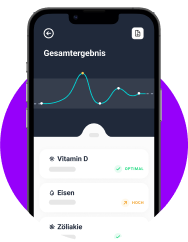Blood test as the best prevention
Our blood makes up one twelfth of our body weight, takes just one minute to flow through our entire body and can be the key to a longer and healthier life. By supplying our cells with oxygen and essential nutrients and removing waste products (such as carbon dioxide and urea), it is essential for our everyday survival.
But it is also fully effective in exceptional situations: it fends off harmful pathogens, regulates our body temperature and helps to seal wounds by clumping together. However, all this only works if the ratio of cells and molecular substances is in balance.
However, if there is a lack of blood cells, platelets or nutrients, our blood can no longer fulfill its functions in the body and our health is at risk. But how do we recognize that we are ill or that our blood count is out of balance? Through a blood test!

Blood tests are one of the simplest and most effective ways of checking our general state of health and gaining an insight into our bodily functions. They are therefore not only useful before operations or when symptoms are present, but should also be carried out regularly by healthy people. The inexpensive and minimally invasive procedure offers the opportunity to proactively prevent the outbreak of diseases and minimize health risks. Doctors therefore recommend a blood test at least every three years or when the following signs appear:

Diffuse complaints
In the case of diffuse symptoms that cannot be clearly assigned to a disease, a blood count is carried out to establish a diagnosis. In this way, malnutrition, food allergies and certain illnesses can be identified.
Acute complaints
Even in life-threatening situations, diagnoses can be confirmed promptly using rapid tests in order to initiate appropriate treatment. For example, protein building blocks in the blood can identify a heart attack.
Chronic diseases
Blood tests are carried out at regular intervals for many diseases to monitor the progression of the disease or to prevent secondary damage. This is the case, for example, with lipometabolic disorders, diabetes and hypothyroidism in order to achieve optimal medication settings.
Pre-operative examinations
Preliminary examinations, which always include a blood count, are arranged before every planned operation. This is to rule out possible risk factors such as blood clotting disorders or acute inflammation.


Suspicion of a disease
Many diseases are initially asymptomatic, but can have far-reaching health consequences or be contagious for other people. This is the case, for example, with sexually transmitted diseases (such as HIV, hepatitis B/C and chlamydia), which is why a blood test can provide certainty.
Dementia & early cancer detection
In order to counteract the increasing prevalence of age-related diseases, blood tests can now be carried out for early disease detection. For example, protein analysis can be used to determine the risk of Alzheimer’s disease or to confirm cancer diagnoses before the onset of acute symptoms. Both processes are still in the development phase, but have already achieved great success in recent years. The eight types of cancer to be identified in future using blood tests include ovarian cancer, liver cancer, stomach cancer, pancreatic cancer, esophageal cancer, colon cancer, lung cancer and breast cancer.
In view of the increase in lifestyle diseases, doctors recommend having the relevant blood values checked regularly. In this way, circulatory diseases, metabolic disorders or even various types of cancer can be detected earlier and better treated or even completely prevented. Blood tests should be carried out more regularly for certain risk factors such as obesity, high blood pressure, recurring infections, nutrient deficiencies or persistent symptoms of fatigue.
To confirm certain diagnoses, the blood is tested for a specific indicator. For all other diffuse symptoms or for regular monitoring, however, small and large blood counts are ordered. In this most common form of blood test, the cellular components of the blood are examined more closely.
The small blood count
The examination is a routine part of general preventive healthcare and when various diseases are suspected. Anemia, infections, inflammations and deficiency symptoms can thus be ruled out or confirmed. If necessary, the doctor can also consult other values and have the liver or kidney values analyzed, for example.
The complete blood count
In addition to the values of the complete blood count, other blood components are determined in the differential blood count. The laboratory concentrates on the white blood cells (leukocytes) and evaluates the percentage of granulocytes, monocytes and lymphocytes to confirm the diagnosis.

The blood test usually takes place early in the morning. This is due to hormone fluctuations depending on the time of day and the interval between the last meal. In order not to falsify the values, it is crucial for most blood tests that the blood sample is taken on an empty stomach and that no medication has been taken. The last meal should therefore be the previous day’s dinner. Water is still allowed, but sugary drinks and alcohol should also be avoided.
The actual blood sample then only takes a few minutes and is usually taken via the vein in the crook of the arm. Depending on the purpose of the test, different samples are taken, labeled with the patient data and a specific barcode and then sent to the laboratory.
As certain components of the blood volatilize very quickly, some blood samples have to be frozen or taken directly in a laboratory. Normally, however, it is sufficient for the blood samples to be collected by a special transport service and analyzed in the nearest laboratory.
The results are then sent back to the attending physician and are available to the patient for consultation one to two days later. In order to clarify possible countermeasures and the need for treatment in the event of abnormal blood values, a follow-up appointment must be arranged with the doctor.
The small blood count is part of the regular health tests that are covered by statutory health insurance as a preventive measure every 2-3 years. Normally, however, the same applies to SHI and private health insurance patients: Anyone who arranges a test at their own discretion must also bear the costs themselves.
However, if it is ordered by a doctor to rule out or confirm an illness, the insurance will pay for both the minor and the major blood count. It is therefore advisable for the individual patient to find out in advance whether the costs are covered by health insurance or how high they are in individual cases.

The blood sample does not necessarily have to be taken by the family doctor, but can also be taken by other trained specialist personnel with a blood sampling certificate. At present, blood samples are also taken for various purposes at the pharmacy, in the medical laboratory, at the DRK blood collection points or in other medical facilities.
To avoid longer waiting times for an appointment at the doctor’s surgery, these options can be a real alternative, depending on the individual case.
A blood sample is a small procedure that can achieve great success in prevention and therapy management. It can prevent, alleviate or cure illnesses more quickly. This low-threshold diagnostic tool is therefore worthwhile for individuals and the population as a whole, as it can greatly reduce the burden on the healthcare system, create a healthier population and be used as an effective preventive tool.
Although the blood test itself only takes a few seconds, it is currently often associated with a time-consuming visit to the doctor. Long journeys, waiting times and cumbersome appointments often make the quick check-up a procedure, especially if it is not a routine examination but the blood values have to be taken regularly due to a temporary abnormality or a long-term illness.
Probatix, on the other hand, aims to provide patients with low-threshold and easy access to testing. With our software, users can call up their blood values more quickly, easily and flexibly and obtain information about the preventive medical check-ups that have been carried out, regardless of their location.
This makes daily life considerably easier, especially for the chronically ill, but also has great benefits for healthy people. The distance and effort to a contact point (such as a pharmacy, laboratory, DRK) is often shorter than to the nearest doctor’s surgery. Probatix then transmits the results.
If values are abnormal, they can be discussed by telephone with the attending physician. However, if all the values are OK, you do not need to do anything else until the next routine examination. The path to a healthy future with Probatix can be that simple. Take the test and stay healthy!

Choose a suitable health test from our wide range of products.
At a Probatix partner near you, a small amount of blood will be taken professionally – usually with a small prick in the fingertip.
Your result will automatically appear in your personal health portal. Including explanations and timelines.